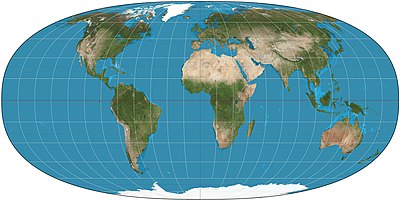Projection hyperelliptique de Tobler


La projection hyperelliptique de Tobler est un type de projection cartographique pseudo-cylindrique équivalente qui peut être utilisée pour les planisphères. Waldo Tobler introduit cette construction en 1973[1].
Généralités
Comme dans n'importe quelle projection pseudo cylindrique[2] les latitudes sont des lignes droites parallèles. Leur espacement est calculé pour conserver les aires. À l'exception du méridien central droit, les longitudes sont des courbes de la forme a|x|γ + b|y|γ = 1 (avec a dépendant de la longitude et b constant pour une carte donnée), connus sous le nom de superellipses[3] ou courbes de Lamé. Quand γ=1 la projection dégénère en une projection de Collignon ; quand γ=2 la projection devient une projection de Mollweide[4]. Les valeurs de γ privilégiées par Tobler sont supérieures à 2.
Notes et références
- (en) Cet article est partiellement ou en totalité issu de l’article de Wikipédia en anglais intitulé « Tobler hyperelliptical projection » (voir la liste des auteurs).
- (en) John P. Snyder, Flattening the Earth: 2000 Years of Map Projections, Chicago, University of Chicago Press, , p. 220
- The Tobler Hyperelliptical Projection on the Center for Spatially Integrated Social Science's site
- "Superellipse" in MathWorld encyclopedia
- Waldo Tobler, « The hyperelliptical and other new pseudocylindrical equal area map projections », Journal of Geophysical Research, vol. 78, no 11, , pp. 1753–1759 (DOI 10.1029/JB078i011p01753, Bibcode 1973JGR....78.1753T)
Text is available under the CC BY-SA 4.0 license; additional terms may apply.
Images, videos and audio are available under their respective licenses.
